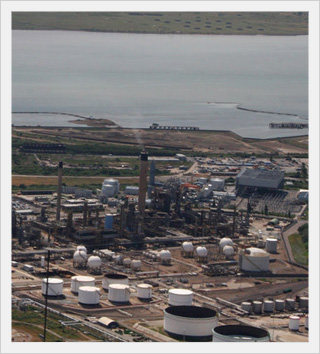 Data collection is the fundamental backbone of all environmental, health & safety management for the oil & gas and chemical industries. Any business that uses tanks as part of their processes should focus on collecting the very best possible data about their sources and use that data intelligently during emissions estimations.
Data collection is the fundamental backbone of all environmental, health & safety management for the oil & gas and chemical industries. Any business that uses tanks as part of their processes should focus on collecting the very best possible data about their sources and use that data intelligently during emissions estimations.
All of the most successful EHS Managers in the Oil & Gas and Chemical industries have a secret... they are data experts. They know that prioritizing in data collection and management are the keys to creating accurate emissions estimates and keeping their business running smoothly.
We’ve condensed the experience of all the expert EHS managers ERA Environmental has worked with for the past two decades into this collection of Tanks Data Collection Best Practices. This article outlines some of the most vital practices your business should be following - are you falling short in any of these data collection and data management areas?
Use Better Data
Your emission estimates are only as good as the data you put into them. When it comes to Oil & Gas or chemical tanks, collecting good data can be difficult. Here are several best practices for getting good data to keep in mind before you run any estimates:
-
Always account for 100% of the total weight of the chemical composition of any material processed through a tank. The best method for this is to obtain a copy of the material composition claim and use that as a data source.
-
Account for temperature variations due to seasonal changes, as temperature affects fugitive emissions. If you’re only taking annual throughput records then slight variations in temperature month-to-month will get missed, so always take monthly readings.
-
Account for the True Vapor Pressure (TVP) of each chemical within each of your materials. TVP can be calculated using the Antoine and Riedel factors. However, if these factors are not available for a specific chemical you can provide two or more TVPs by interpolating from given material TVPs.
-
Remember to track waste shipped off site. Even though you can’t claim credits for waste from tank cleaning, it will be required for TRI reporting. Use the material’s SDS or perform waste testing to get a speciated profile for all shipped waste.
Higher Frequency, Better Results
Throughput is the rate at which your business is able to produce your product out of incoming materials within a given unit of time. The higher your throughput rate is more competitive in the market and generally are more efficient at processing materials. Throughput is also an important factor in determining your reportable emissions.
And that’s why it’s a best practice to maintain accurate throughput records on a regular basis - the more often the better. Because they’re busy, sometimes EHS professionals create infrequent throughput records (once a quarter, as needed, etc.). Unfortunately, this often creates gaps in data and doesn’t provide a reliable ongoing picture of where your operations stand.
In our experience working with tank operators, anyone doing record keeping and data collection manually (i.e spreadsheets) should strive to maintain throughput records on a monthly schedule. Having monthly throughput records is the minimum for producing realistic and useful emissions estimates.
If you’re physically able to collect data more frequently than once a month, you will see even greater results. However, many EHS managers begin to see diminishing returns on how these benefits compared to the hours and effort required to take daily or hourly readings of their environmental metrics. That’s why it’s quickly becoming a standard practice to use an electronic reporting platform and other types of data collection systems to increase collection frequency without increasing effort or time costs.
Which leads to the next data collection best practice…
Continuous Monitoring
Installing Continuous Monitoring Systems (CMS) for your tanks, flares, and other sources is hands-down the most representative way to estimate emissions. Although monthly monitoring of certain factors is a good data management base level, it’s only with minute-to-minute real-time monitoring that you can achieve the highest levels of accuracy and be able to proactively circumvent compliance issues.
Continuous monitoring comes in different forms:
-
Parameter monitoring (CPM) - monitors the performance and operating conditions of your equipment (for example, the temperature at which a flare is combusting emissions).
-
Emissions monitoring (CEM) - monitors the different emissions from a certain source. Can be applied to many types of emissions, including particulate matter, NOx SO2, CO and chemical emissions into the air.
ERA recommends combining continuous monitoring with discrete sampling campaigns and by assessing fuel consumption to determine flue gas volume flow at a standard dilution. Manual sampling is still needed for calibration purposes. CMS devices also provide more benefits when applied to your largest sources (i.e combustion systems). Remember, not every factor in your overall emissions needs to be collected at the same frequency in order to produce accurate results - there are some smaller sources that will be more cost effective to monitor without CMS.
It must be recognized that continuous monitoring is not the same as continuous measurement: CMS technology won’t tell you everything you need about your emissions and you’ll still need to process that data into an emissions estimate either by hand or using an electronic reporting tool that automatically taps into CMS data without manual intervention. No surprise here: an integrated EHS software system is the more efficient choice.
Find your Ideal Estimation Method
Most emissions sources for the Oil & Gas and Chemical industries have several different options for how to estimate their emissions, all developed and approved by reliable regulatory agencies (i.e. US EPA, API, CONCAWE).
Depending on your air permits, the method of estimating emissions could be up to you to decide or could be prescribed by your regulators. In both cases, be sure to carefully document which method(s) you use - this will become essential later if you ever get audited or choose to do internal quality assurance.
There are three main methods to choose from, and whichever you choose should be consistent with the objectives of your emissions inventory, information availability, and time/material resources on hand:
Average Factors. Industry average factors have been published for a wide range of source types and are often used for initial inventories until more source-specific and representative data is available. Average factors are typically used by multiplying the published factor by an operating parameter - such as throughput of fuel combusted (see point #1) - to estimate emissions. Average factors are not the most preferable method to use once you have more data on hand to use in more sophisticated calculations.
Correlations. Correlations are emission calculations that attempt to incorporate major design and operating parameters of a source in order to create a more specific and representative estimate. The more operating variables a correlation incorporates, the more accurate the final result will be.
Correlations method is commonly applied to tanks and wastewater treatment. A common example would be the AP-42 calculations for the different types of tanks, which attempts to account for tank roof type, color, material, etc., in determining emissions.
Because correlations can become quite complex and the effort required per tank can be intensive, correlation estimates are often handled as part of a computer model.
Computer/Virtual Modelling. Software systems are capable of mapping out all the different emission variables and source parameters into a centralized database, and using that database to complete the complex emission estimates using correlative equations. Computer modelling is widely accepted by regulatory agencies, and most manufacturers find this method to be preferable due to a lower time cost and overall lower labor cost. A simplified example of computer modelling would be the EPA TANKS e-reporting tool, which can estimate emissions for very basic tank setups. Be aware, however, that TANKS is considered an imperfect tool and will not be accepted by regulators for many different scenarios. If computer modelling is of interest to your business, it is recommended you seek out a more reliable third-party system.
Assure Quality: Develop, Audit, Improve
EHS Managers live by the code of Plan-Do-Check-Act. And data collection is no different.
One of the most important best practices for data collection and data management is to develop an emissions inventory to assess your overall compliance, then use that inventory as an auditing tool for your data management procedures. ERA recommends that EHS Managers also get the active involvement of senior management in this process, as it will help secure the resources to perform a thorough and useful quality assurance audit - and demonstrate how investing in further EHS development will benefit the entire business.
Develop
Here are the best practices for developing an emissions inventory that EHS professionals find most useful:
-
Ensure all emissions sources are included in the inventory - cherry-picking will reduce your benefits after the audit, even if it makes you look good for the moment.
-
Use the most effective estimating methods, which may not be the same for every source. Focus on quality results, not the fastest results.
-
Compile and centralize representative equipment design and operations data. Have a reliable source of information about your sources and equipment you can easily reference for correlative calculations.
-
Document all assumptions and methodologies used for each individual source.
Audit
Once you’ve created your emissions inventory (which can be used to demonstrate compliance with limits and track your continual improvement progress), it’s time to conduct an independent and systematic audit of your data collection and data management procedures. You’ll be able to identify potential areas for improvement, minimize errors, and create more representative estimates.
Here are the best practices for auditing an emissions inventory:
-
Check to see if there are more appropriate or representative methods that could be used for sources. Was one less accurate method used because a piece of data was missing? Was one type of calculation too time consuming to do manually for each tank, and so a less representative one was used? What would need to be improved to use the better estimation methodology?
-
Ensure all assumptions and methodologies are reasonable and fully documented. Would an auditor be able to understand the inventory without having an EHS Manager present to answer questions? Will someone within your organization get the same results without your guidance?
-
Is your source list complete? Were any skipped due to time constraints? Having a comprehensive source list is the most critical item to develop as an EHS department.
-
Elect a sustainability leader to lead the audit process and bridge the EHS team and the executive team’s goals.
-
Where did you store material and source data and in which format was it kept? Data should be centralized, standardized, and secure… but easy to access for anyone that needs it.
Improve
Documenting and communicating the results of your audit is an essential step: failing to flag problems means making improvements will not be possible.
In general, audit findings on data collection and management fall into two categories:
-
Items with errors that need to be corrected (an incorrect estimate or missing source).
-
Items where improvements can be made to increase estimate accuracy.
Be sure to list the source affected, a detailed description of the issue, and all recommendations for improvement. While those points are standard procedure, a less common best practice is to also centralize your audit findings. ERA also recommends that you develop a standardized set of audit questions that you apply to all future emission inventories as follow up.
What are Your Best Practices?
These are some of the most helpful best practices for data collection and management we’ve implemented for businesses using tank and needing to improve their tank EHS management. Do you have a secret tactic that our list is missing? Let us and your fellow EHS Managers know in the comments below.
Image credit: joanna deSilva via creative commons
This Blog was Co-Authored By:


Tags:
Air Management
September 15, 2014
Comments